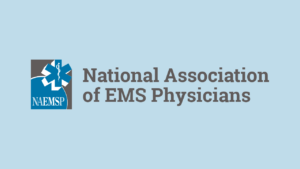
We are on the cusp of our long-awaited House Bill becoming reality. The draft language has been completed, and we hope that our bill, “When Minutes Count for EMS Patients”, will be introduced in Congress soon. With this newsletter message, I would like to begin familiarizing our members with the concepts in this proposed bill.
We have had a lot of advocacy activity recently. In mid-March, NAEMT invited Dr. David Tan (Advocacy Committee Chair) and me to attend a breakfast event for the Congressional EMS Caucus. The caucus leaders (Richard Hudson (R-NC) and Debbie Dingle (D-MI) addressed the group, focusing on the importance of a strong EMS system. NAEMT president Chris Way spoke about their pending bills that focus on reimbursement for treat-in-place and MIH, and I had the opportunity to introduce the principles of our proposed bill.
The “When Minutes Count for EMS Patients Bill” is the result of a couple years of work by our Advocacy Committee and our Board, and it strengthens the EMS system through 1) recognizing the value of EMS medical direction through compensation, 2) ensuring the availability of essential EMS medications and blood products, and 3) drawing attention to ED crowding and “wall time” for EMS patients.
The direct and indirect medical oversight provided by EMS medical directors is essential to high-quality and safe care provided by EMS agencies and their clinicians, yet many EMS medical directors have been inadequately compensated for this. Our legislative bill directs MedPAC to conduct a study on the compensation needed to attract and retain EMS physicians who oversee the highest level of quality care and EMS clinicians to deliver that care.
Medication shortages continue to occur, and shortages of essential EMS medications affect our ability to safely care for our patients. Unlike hospitals, we know that EMS agencies have limited resources to safely provide alternatives to medication shortages that affect our ability to provide care for our patients. To address the shortages of medications that are essential to EMS care, we call for a CMMI (Centers for Medicare & Medicaid Innovations) demonstration program to evaluate a separate payment for essential emergency medications in shortage.
In addition to essential EMS medications, the bill also includes reimbursement for blood and blood products in this CMMI project. Blood products are lifesaving and are increasingly being adopted by EMS agencies, but their cost is one of the impediments to large scale availability to EMS patients. NAEMSP has been one of many organizations participating in the Prehospital Blood Administration Collaborative that seeks to overcome these barriers and make blood products available to EMS patients across the U.S.. The collaborative is chaired by former NAEMSP president Dr. Jon Krohmer.
Lastly, to draw attention to ED crowding and its negative effects on EMS patient care and our EMS system, the bill requires HHS to reissue guidance to hospitals to address this “wall time” crisis and report to Congress on how to effectively tackle the persistent issues plaguing hospitals and EMS systems due to crowding and boarding.
Stay tuned for opportunities to help advance our bill to law. I hope you will consider joining us for the NAEMSP Government Relations Academy in Washington, DC on May 14th and our day visiting congressmembers on May 15th. You can register for these free sessions on the NAEMSP website until the deadline on May 1. We will need everyone’s help to educate our legislators about these quality of care and safety issues for our patients.

